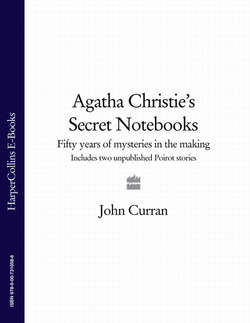Читать книгу Agatha Christie’s Secret Notebooks: Fifty Years of Mysteries in the Making - Includes Two Unpublished Poirot Stories - John Curran - Страница 41
4 Cat among the Pigeons:The Nursery Rhyme Murders
Оглавление‘I adore nursery rhymes, don’t you? Always so tragic and macabre. That’s why children like them.’
The Mousetrap, I, i
SOLUTIONS REVEALED
Crooked House • Five Little Pigs • ‘Four and Twenty Blackbirds’ • Hickory Dickory Dock • ‘How Does Your Garden Grow?’ • Ordeal by Innocence • A Pocket Full of Rye • ‘Sing a Song of Sixpence’ • Ten Little Niggers • ‘The Tuesday Night Club’
The attraction of children’s literature, either as titles or themes, has often provided crime writers with inspiration. Dickson Carr’s The Arabian Nights Murder, Douglas Browne’s The Looking Glass Murders, McBain’s Snow White and Rose Red and Rumpelstiltskin, Queen’s There Was an Old Woman, Smith’s This Is the House, Witting’s There Was a Crooked Man and Fuller’s With My Little Eye are all drawn from the playroom, while S.S. Van Dine’s The Bishop Murder Case uses Mother Goose as a theme. The attraction is obvious—the juxtaposition of the childlike and the chilling, the twisting of the mundane into the macabre.
But it was Agatha Christie who made it her own and exploited it more comprehensively than any other writer. There are numerous references to nursery rhymes scattered throughout the Notebooks. Sometimes the idea went no further than a brief jotting (see ‘Miscellaneous’ on page 129); others provided her with some of her greatest works—Ten Little Niggers, Five Little Pigs and Three Blind Mice/The Mousetrap. In some cases it provides no more than a title, Hickory Dickory Dock and One, Two, Buckle my Shoe; in some cases, Ten Little Niggers and A Pocket Full of Rye, it provides the book with an overall schema; while the use of Crooked House and Three Blind Mice is more symbolic than actual. The most successful are undoubtedly Five Little Pigs and Ten Little Niggers, where the rhyme is convincingly and ingeniously followed. The dramatic impact of an innocent nursery rhyme transforming into a killer’s calling card is irresistible to an imaginative crime writer such as Agatha Christie.
Sing a song of sixpence, a pocket full of rye, Four and twenty blackbirds, baked in a pie, When the pie was opened, the birds began to sing, Was not that a dainty dish to set before the king?
The king was in his counting-house, counting out his money, The queen was in the parlour, eating bread and honey, The maid was in the garden, hanging out the clothes When down came a blackbird and pecked off her nose.
The most fruitful nursery rhyme was ‘Sing a Song of Sixpence’, which provided no less than three titles: the novel A Pocket Full of Rye, and the short stories ‘Sing a Song of Sixpence’ and ‘Four and Twenty Blackbirds’. In the case of the short stories, only the title has been inspired by the rhyme, whereas the novel follows the pattern of the rhyme very closely.
